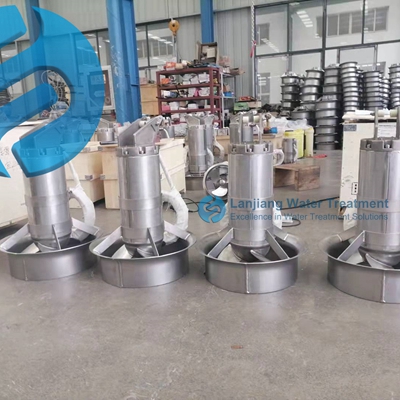The mixing speed of sewage mixer has significant influence on the efficiency of sewage treatment. Specifically, the choice of mixing speed needs to be comprehensively considered according to the nature of the sewage, the treatment process, and the type and size of the mixer to ensure the best mixing effect and sewage treatment efficiency.
First, the effect of mixing speed on mixing effect
The mixing speed directly affects the mixing effect of solid and liquid components in sewage. The correct stirring speed can make the suspended matter and microorganisms in the sewage evenly mixed, promote the oxidation and precipitation reaction of organic matter, thus improving the water quality. If the mixing speed is too fast, it will produce too many bubbles and water flow, which may take away microorganisms and particles together, weaken the adhesion, deposition and metabolism of microorganisms, and reduce the effect of water quality treatment. On the contrary, if the mixing speed is too low, it can not effectively promote the flow and mixing of the mixture, resulting in organic matter is difficult to fully oxidize and precipitate, which will also affect the efficiency of sewage treatment.

Second, the basis for the selection of mixing speed
1. Sewage properties: Different types of sewage have different requirements for mixing speed. For example, sewage with a high concentration of suspended solids may require a higher stirring speed to ensure a uniform dispersion of suspended solids.
2. Treatment process: Different sewage treatment processes have different requirements for mixing effects. For example, in processes such as biological nitrogen removal and biological phosphorus removal, the mixing speed and mixing time need to be strictly controlled to ensure that the metabolic reaction of microorganisms is fully carried out.
3. Mixer type and size: Different types of agitators (such as propulsion, paddle, anchor, etc.) and size have different requirements for mixing speed. A large mixer may require a lower speed to achieve the desired line speed, while a small mixer may require a higher speed.
Third, the best mixing speed range
According to research, the best mixing speed range in sewage treatment is usually between 20-25rpm, and the best mixing effect can be obtained at this time. However, this range is not absolute, and the specific value needs to be adjusted according to the actual situation. In some specific sewage treatment processes, such as biological nitrogen removal and biological phosphorus removal, the mixing speed also needs to be carefully regulated according to sewage characteristics and treatment requirements.
Fourth, the comprehensive impact of mixing speed on sewage treatment efficiency
1. Improve treatment efficiency: By maintaining the uniform distribution of substances in sewage, accelerate the rate of biodegradation and chemical reaction, thereby improving the efficiency of sewage treatment.
2. Promote sludge settlement: The appropriate mixing speed can prevent the uneven settlement of sludge in the sedimentation tank and improve the settlement efficiency.
3. Maintain the mixed state: In activated sludge treatment, stirring helps to maintain the mixed state of sludge and sewage, ensuring that microorganisms can effectively decompose pollutants.
In summary, the mixing speed of sewage mixer has an important influence on the efficiency of sewage treatment. In practical application, the appropriate stirring speed range should be selected according to the characteristics of sewage, treatment process and agitator type and size, so as to achieve the best sewage treatment effect.
Post time:2024-07-07